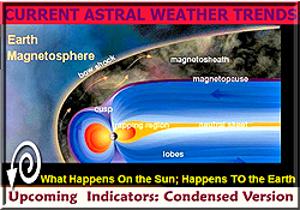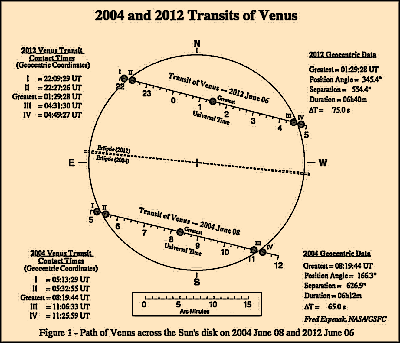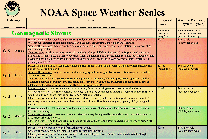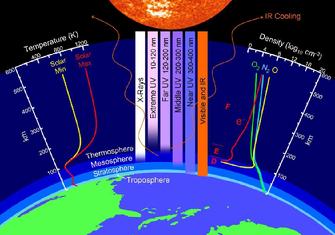Solar X-Rays:
Geomagnetic Field: |
 |
 |
>
| |
| |
|
 |
| What Are Some of The Current Transiting Trends? |
|
|
|
|
|
WHAT TIME IS IT? - WHAT YEAR IS IT?
|
|
|
 |
| Skip To: Time Zone Converter |
|
|
|
*Hit F5 or Reload To Be Sure You Have The Latest Update*
|
|
|
UPCOMING ASTRONOMICAL INFO (Times: UT)
- Tue May 29 14h FULL MOON
- Fri Jun 01 01h Saturn 01° 24' S. of Moon
- Sat Jun 02 17h Moon at apogee
- Sun Jun 03 12h Mars 03° S. of Moon
- Wed Jun 06 02h Mercury in superior conjunction
Wed Jun 06 18h Neptune 02° N. of Moon
Wed Jun 06 19h LAST QUARTER
- Sat Jun 09 01h Venus 05° S. of Pollux
- Sun Jun 10 03h Uranus 05° N. of Moon
|
|
T R A N S I T S OF V E N U S
|
|
- Venus is known as the "Twin Star": One reason for this ... it is seen in the sky as a "morning star" AND an "evening star" ... ALSO, Venus makes "2" transits across the Sun
- The Mayan calendar began as a "Birth of Venus" in 3113 BC. The Maya predicted the Sun's magnetic field would shift direction after 3,740 years. At the times of Solar Magnetic Field Shifts; the Sun's interaction with the Earth's magnetic field allows excessive radiation (from the Sun) to enter Earth's magnetosphere/atmosphere, with varying results depending upon the Earth's own magnetic fields & axial tilt.
- The Maya predicted that their own civilization would decline after/when the Sun shifted its magnetic field. So, it must be that special condtions would exist between the Earth & the Sun at that time. From the begining date of the Mayan calendar in 3113 BC + 3740 years = 627 AD. The Mayan civilization did in fact, collapse after that time.
|
 |
| TRANSITS OF VENUS: Click On Image To Enlarge |
|
|
- Transits of Venus across the disk of the Sun are among the rarest of planetary alignments & only six such events have occurred since the invention of the telescope.
(1631, 1639, 1761, 1769, 1874, 1882)
The last transit of Venus occurred on June the 6th, 2012.
- Transits of Venus are only possible during early December and early June when Venus's orbital nodes pass across the Sun.
- If Venus reaches inferior conjunction at this time, a transit will occur... and so far, they occur at intervals of: 8 - 1211/2 - 8 - 1051/2 Years.
- The next set of Venus transits won't occur until:
- Dec. 11th, 2117
- and -
- Dec. 08th, 2125
|
|
HOW MANY MILES = A DEGREE?
|
|
- A degree of latitude: roughly 69 miles
- A minute of latitude: roughly 1.15 miles
- A second of latitude: roughly 0.02 miles (or just over 100 feet)
- Degree of Longitude: at Equator: roughly 69 miles
- Degree of Longitude: at 45º Latitude: roughly 49 miles
|
D
I
S
T
A
N
C
E
|
Solar X-Rays:
Geomagnetic Field: |
 |
 |
>
| |
| "INCOMING" • SOLAR DATA & INFO
Use the "SKIP TO" Links Below:
↓
|
|
Geomagnetic Storm Forecasts
Active: K = 4.
Minor storm: K = 5.
Major or Severe storm: K > 6.
- The K index measures the deviation of the most disturbed horizontal component of the Earth's magnetic field over 3 hour intervals. (Its got to hit 5 or over to qualify as a Solar Storm)
Geomagnetic Storm Levels
Kp=5 [G1]
Kp=6 [G2]
Kp=7 [G3]
Kp=8 [G4]
Kp=9 [G5]
- As the Earth’s magnetic field (the Geomagnetic field) reacts to an energy output from the Sun by making certain changes; and as the Geomagnetic field changes; new forms can occur which then release magnetic energy fields. These magnetic fields are fast moving, electrically charged particles that then, travel along the Earth's magnetic field lines.
- Some, however go to the Earth's upper atmosphere which we see as "Auroras".
- The K indexes and G indexes give an idea of the degree and type of the magnetic energies hitting the earth.
|
|
- Geomagnetic Storms: disturbances in the geomagnetic field caused by gusts in the solar wind that blows by Earth - [G1-G2-G3-G4-G5]
- Solar Radiation Storms: elevated levels of radiation that occur when the numbers of energetic particles increase - [S1-S2-S3-S4-S5]
- Radio Blackouts: disturbances of the ionosphere caused by X-ray emissions from the Sun - [R1-R2-R3-R4-R5]
DEFINITIONS ARE BELOW
↓
|
S
T
O
R
M
S
|
 |
| GeoMagnetic Storm Definitions (click image to enlarge) |
|
|
 |
| Solar Radiation Storm Definitions (Click Image To Enlarge) |
|
|
 |
| Radio BlackOut Definitions (Click Image To Enlarge) |
|
|
 |
| The Earth "Catching Some (solar) Rays" |
|
|
- A Solar Flare is an explosion on the Sun that happens when energy stored in twisted magnetic fields (usually above sunspots) is suddenly released. Flares produce a burst of radiation across the electromagnetic spectrum, from radio waves to x-rays and gamma-rays
|
- A Coronal Hole Occurs when a hole opens up on the Sun; This "hole" consists of exposed magnetic field lines which get released into space as a "strong & fast moving" solar wind containing magnetic waves & particles ... traveling at about 1.8 million mph. Should the Coronal Hole be facing Earth during a release; then these magnetic waves & particles head our way producing auroras, etc.
|
|
|
PROTON FLUX
- S1: < 100 pfu
- S2: < 1000 pfu
- S3: < 10,000 pfu
- S4: < 100.000 pfu
- S5: > 100.000 pfu
| X- RAY FLARES
- X: "Big" - Can trigger planet-wide radio blackouts and long-lasting radiation storms.
- M: "Medium" - Can cause brief radio blackouts that affect Earth's polar regions as well as minor radiation storms.
- C: "Small: Barely noticeable interruptions.
|
|